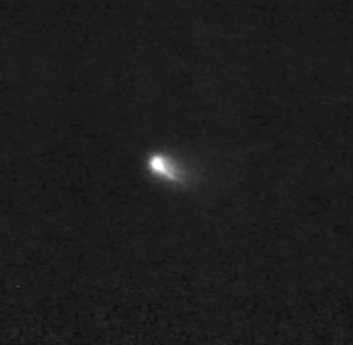|
Oct 29, 2000
80 Kb RealVideo movie of an
Orionid or a north or south Taurid. You pick.
October 20,21,22, 2000 ~ Orionids !
Imaged the Orionids; captured several meteors using a Gen 2
Image inensifier (18mm collection area) and a 12.5 mm f/1.2 "C" mount lens with a PC-23-C
camera with an 9mm C mount lens recording to a VHS tape . FOV is around 55 degrees
with a LM of around mag 5.0 for the system, with the existing moon light.
76Kb RealVideo Movie of Mag -1 Orionid
51 Kb RealVideo movie of an Orionid meteor that reaches around mag -2.
The actual video looks a million times better than the RealVideo movies.
Here is a quick look at some of the data:
10/20/2000 (47 minutes) starting 07:59:30 UT ending 08:46:00 UT
6 Orionids, 2 non-Orionids.
10/21/2000 (35 minutes) starting 07:10 UT ending 07:45 UT
6 Orionids, 0 non-Orionids
10/22/2000 (45 minutes) starting 03:30 UT ending 04:15 UT
5 Orionids, others not noted.
10/22/2000 (42 minutes) starting 05:00 UT ending 05:42 UT
6 Orionids, 0 non-Orionids
10/22/2000 (56 minutes) starting 06:04 UT ending 07:00 UT
4 Orionids, others not noted.
Most meteors were between mag 1 and mag 3; 1 meteor was just a
bit dimmer than the brightness of Jupiter, somewhere around mag -1 and one
was around mag -2 (see RealVideo links above).
One mention is that when compared to
the typical Leonid meteor, there is no disruption on WWV at 10,000 KHz with Orionids.
Leonids typically cause an additional sound on Ham Radio that is comparable to the
sound of some kind of a soft drink being poured into a graduated cylinder. As the cylinder becomes
fuller, and the bubbles reach the top, the pitch of the sound that they make would increase.
Leonids have that sort of "fizzing" sound on Ham. One may even venture to guess that the Leonids
and their trajectory thru the field lines of the Earth's magnetic field simply cut more field lines than
the Orionids.
It was a good trial run for the Leonids which will have a moon comparable to the Oct 18 moon.
I will be shooting the Leonids in a westward direction, 90 degrees west of the moon, where there
seems to be a better chance of seeing them due to polarization of the moon light (and weather permitting:).
23:49UT October 13, 2000
351 KB RealVideo movie of ISS and STS-92
Imaged with Gen II image intensifier and PC-23-C video camera.
~23:19UT October 12, 2000
459 KB RealVideo movie of ISS Imaged with Gen II image intensifier
and PC-23-C video camera. It was still fairly light outside. An airplane is the blinking object and the other object heading
down into the trees is the ISS.
23:21UT October 11, 2000 STS-92 LAUNCH !!!
Space Shuttle STS-92 heading up the East Coast as imaged from Mount Airy, Maryland, some 5 minutes after liftoff!
This was my first launch and it was spectacular! Now if I can only get a few hundred miles closer some day for a launch...WAHoooo!!
455 Kb RealVideo Slo-motion segment
713 Kb RealVideo --
1 Mb QuickTime

Space Shuttle STS-92 heading up the East coast of the US a few minutes after liftoff;
Imaged with Orion 80mm f/5 refractor with PC-23-C video camera at prime focus.
Captured from Mount Airy, Maryland around 23:21UT October 11, 2000. STS-92's
location is perhaps less than 100 miles off the coast of the Outer Banks of North
Carolina or Virginia beach.
|